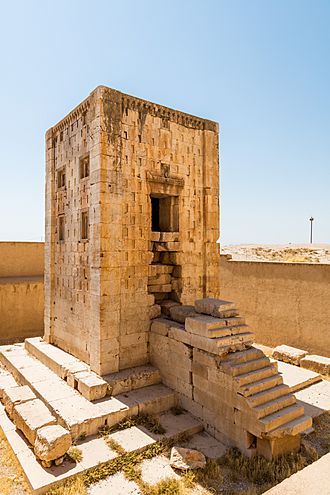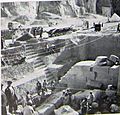Ka'ba-ye Zartosht facts for kids
Quick facts for kids Cube of Zoroaster |
|
|---|---|
 |
|
| Former names | Bon-Khanak (Sassanian era) |
| Alternative names | Kornaykhaneh Naggarekhaneh |
| General information | |
| Type | Tower, stone chamber |
| Location | Marvdasht, Iran |
| Construction started | First half of sixth century B.C., Achaemenid era |
| Owner | Cultural Heritage, Handicrafts and Tourism Organization of Iran |
The Ka'ba-ye Zartosht (which means "Cube of Zoroaster" in Persian) is an ancient stone building in Iran. It looks like a tall, square tower with steps. This special structure is found in the Naqsh-e Rustam area, near the village of Zangiabad in Marvdasht county, Fars.
This building is very old, dating back to the first half of the sixth century B.C.. This was during the time of the Achaemenid Empire, a powerful ancient Persian empire. The Ka'ba-ye Zartosht stands out because of its unique design and its long history.
Contents
What is the Cube of Zoroaster?
The Ka'ba-ye Zartosht is a stone tower that is about 14 meters (46 feet) tall. It has a square base and a single room inside. The outside walls are decorated with false windows and doors. A grand staircase leads up to the entrance of the chamber.
Historians and archaeologists have studied this building for a long time. They believe it was built during the Achaemenid Empire, possibly around the time of Darius I or Xerxes I. Its exact purpose is still a bit of a mystery, but there are several ideas.
What was its purpose?
Many experts have tried to figure out why the Ka'ba-ye Zartosht was built. Here are some of the main theories:
- A Fire Temple: Some believe it was a place for religious ceremonies, especially for the ancient Persian religion of Zoroastrianism. Fire was very important in Zoroastrian rituals, so it might have held a sacred fire.
- A Royal Tomb: Another idea is that it was a tomb for an Achaemenid king or a very important person. However, no remains have ever been found inside.
- A Treasury or Archive: Some scholars think it might have been a place to store important documents, royal treasures, or sacred objects. Its strong stone walls would have kept things safe.
- An Astronomical Observatory: A less common theory suggests it could have been used to observe the stars and planets.
Even though its exact use is not known, the building's design suggests it was very important. It was built with great care and skill, showing the advanced engineering of the Achaemenid period.
Where is it located?
The Ka'ba-ye Zartosht is part of the larger Naqsh-e Rostam complex. This site is famous for its rock-cut tombs of Achaemenid kings, including Darius I, Xerxes I, Artaxerxes I, and Darius II. There are also impressive rock carvings from the later Sasanian Empire.
The tower stands directly opposite the tomb of Darius II. This placement suggests a connection to the royal tombs and the religious beliefs of the time. The entire Naqsh-e Rostam site is a significant historical place that tells us a lot about ancient Persian history and culture.
A guided tour of Ka'ba-ye Zartosht, YouTube (1 min 34 sec).
Images for kids
-
Ka'ba-ye Zartosht in front of Darius II's mausoleum
-
A picture of Naqsh-e Rustam painted by Jean Chardin in 1723
-
Photograph of the excavations performed by the Oriental Institute of the University of Chicago
-
Ka'ba-ye Zartosht in the nineteenth century, by Jane Dieulafoy
-
The Parthian-language version of Shapur I's inscription
-
The place of the inscriptions of Kartir and Shapur I (the Sassanian Middle Persian version) on the walls of Ka'ba-ye Zartosht
See also
 In Spanish: Ka'ba-i-Zartosht para niños
In Spanish: Ka'ba-i-Zartosht para niños













